The AMD Threadripper 2990WX 32-Core and 2950X 16-Core Review
by Dr. Ian Cutress on August 13, 2018 9:00 AM ESTHEDT Benchmarks: Encoding Tests
With the rise of streaming, vlogs, and video content as a whole, encoding and transcoding tests are becoming ever more important. Not only are more home users and gamers needing to convert video files into something more manageable, for streaming or archival purposes, but the servers that manage the output also manage around data and log files with compression and decompression. Our encoding tasks are focused around these important scenarios, with input from the community for the best implementation of real-world testing.
Handbrake 1.1.0: Streaming and Archival Video Transcoding
A popular open source tool, Handbrake is the anything-to-anything video conversion software that a number of people use as a reference point. The danger is always on version numbers and optimization, for example the latest versions of the software can take advantage of AVX-512 and OpenCL to accelerate certain types of transcoding and algorithms. The version we use here is a pure CPU play, with common transcoding variations.
We have split Handbrake up into several tests, using a Logitech C920 1080p60 native webcam recording (essentially a streamer recording), and convert them into two types of streaming formats and one for archival. The output settings used are:
- 720p60 at 6000 kbps constant bit rate, fast setting, high profile
- 1080p60 at 3500 kbps constant bit rate, faster setting, main profile
- 1080p60 HEVC at 3500 kbps variable bit rate, fast setting, main profile
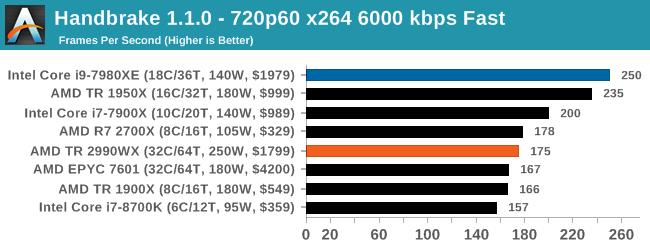
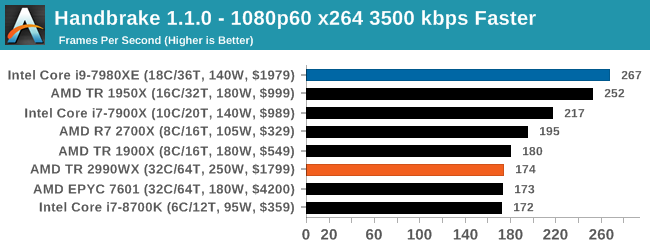
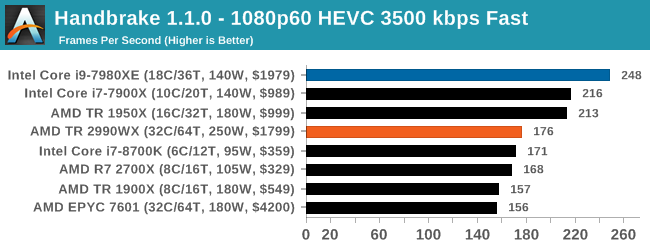
Video encoding is always an interesting mix of multi-threading, memory latency, and compute. The Core i9, with AVX2 instructions, sets a commanding lead in all three tests. The AMD processors seem to fluctuate a bit, with the 1950X and 2700X being the best of the bunch. Unfortunately we didn’t get 2950X results in our initial runs, but I would expect it to be competitive with the Core i9 for sure, given where the 1950X is. However the 2990WX does fall behind a bit.
7-zip v1805: Popular Open-Source Encoding Engine
Out of our compression/decompression tool tests, 7-zip is the most requested and comes with a built-in benchmark. For our test suite, we’ve pulled the latest version of the software and we run the benchmark from the command line, reporting the compression, decompression, and a combined score.
It is noted in this benchmark that the latest multi-die processors have very bi-modal performance between compression and decompression, performing well in one and badly in the other. There are also discussions around how the Windows Scheduler is implementing every thread. As we get more results, it will be interesting to see how this plays out.
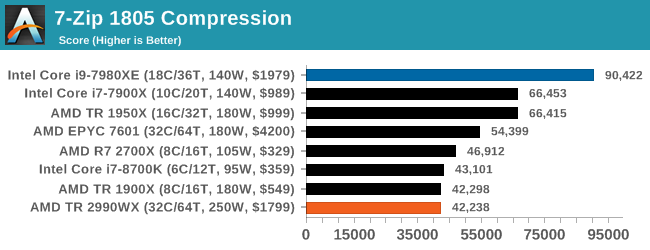
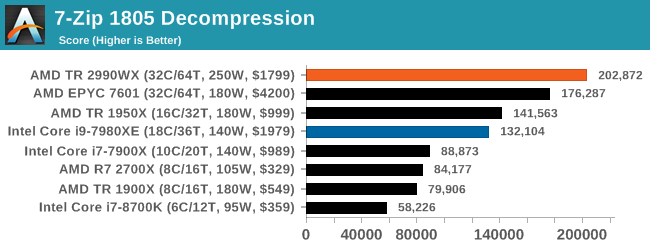
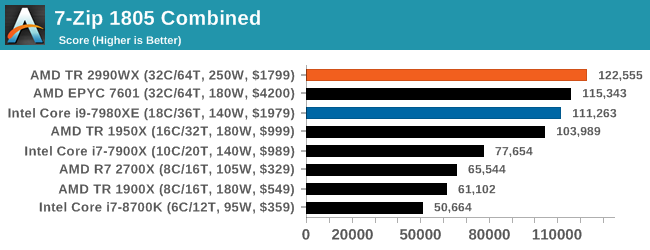
Oh boy, this was an interesting set of tests. When we initially published this review, without commentary, the compression graph with the 2990WX at the bottom was shared around social media like crazy, trying to paint a picture of why AMD performance isn’t great. It was also used in conjuction with Phoronix’s tests, that showed a much better picture on Linux.
But what confuses me is that almost no-one also posted the decompression graph. Here AMD’s 32-core processors take a commanding lead, with the 16/18-core parts being the best of the rest.
If you plan to share out the Compression graph, please include the Decompression one. Otherwise you’re only presenting half a picture.
WinRAR 5.60b3: Archiving Tool
My compression tool of choice is often WinRAR, having been one of the first tools a number of my generation used over two decades ago. The interface has not changed much, although the integration with Windows right click commands is always a plus. It has no in-built test, so we run a compression over a set directory containing over thirty 60-second video files and 2000 small web-based files at a normal compression rate.
WinRAR is variable threaded but also susceptible to caching, so in our test we run it 10 times and take the average of the last five, leaving the test purely for raw CPU compute performance.

A set of high frequency cores and good memory is usually beneficial, but sometimes some more memory bandwidth and lower latency helps. At the top is AMD’s R7 2700X, with the Intel 10-core just behind. I’m surprised not to see the 8700K in there, perhaps its six cores is not enough. But the higher core count AMD parts struggle to gain traction here, with the 32-core parts taking some sweet time to finish this test.
AES Encryption: File Security
A number of platforms, particularly mobile devices, are now offering encryption by default with file systems in order to protect the contents. Windows based devices have these options as well, often applied by BitLocker or third-party software. In our AES encryption test, we used the discontinued TrueCrypt for its built-in benchmark, which tests several encryption algorithms directly in memory.
The data we take for this test is the combined AES encrypt/decrypt performance, measured in gigabytes per second. The software does use AES commands for processors that offer hardware selection, however not AVX-512.
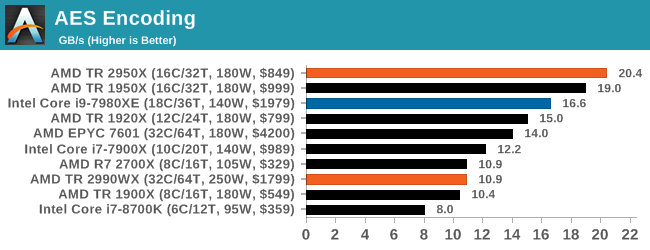
Normally we see this test go very well when there are plenty of cores, but it would seem that the bi-modal nature of the cores and memory controllers in the 2990WX gives a poor result. The EPYC 7601, with eight memory controllers, does a better job, however the 1950X wins here. The 2950X, where all cores have a similar access profile, scores top here, well above Intel’s 18-core Core i9.










171 Comments
View All Comments
3DVagabond - Wednesday, August 15, 2018 - link
When did you switch to this new benchmark suite?Lord of the Bored - Wednesday, August 15, 2018 - link
Still writing...mukiex - Friday, August 17, 2018 - link
Looks like it's no longer a problem! They deleted all those pages.GreenReaper - Saturday, August 18, 2018 - link
They're back again now.abufrejoval - Wednesday, August 15, 2018 - link
Separating CPU (and GPU) cores from their memory clearly doesn't seem sustainable going forward.That's why I find the custom chip did for the chinese console so interesting: If they did an HBM variant, perhaps another with 16 or even 32GB per SoC, they'd use the IF mostly for IPC/non-local memory access and the chance of using GPGPU compute for truly parallel algorithms would be much bigger as the latency of context switches between CPU and GPU code would be minimal with both using the same physical memory space.
They might still put ordinary RAM or NV-RAM somewhere to the side as secondary storage, so it looks a little like Knights Landing.
IF interconnects might be a little longer, really long when you scale beyond what you can fit on a single board and probably something where optical interconnects would be better (once you got them...)
I keep having visions of plenty of such 4x boards swimming immersed in a tank of this "mineral oil" stuff that evidently has little to do with oil but allows so much more density and could run around those chips 'naked'.
Alaa - Wednesday, August 15, 2018 - link
I do not think that testing only a single tool at a time is a good benchmark for such high core count architecture. These cores need concurrent workloads to showcase their real power.csell - Thursday, August 16, 2018 - link
Can somebody please tell me the difference between the ASUS ROG Zenith Extreme motherboard rev 2 used here and the old ASUS ROG Zenith Extreme motherboard. I can't find any information about the rev 2 somewhere else?UnNameless - Friday, August 17, 2018 - link
I also want to know that. I have the "rev 1" Asus rog zenith extreme and can't find any difference.spikespiegal - Friday, August 17, 2018 - link
Companies buy PC's to run applications and don't care about memory timing, CPU's, clock speed or any other MB architecture. They only care about the box on the desk to run applications and ROI, as they should. AMD has historically only made a dent in the low end desktop market because Intel has this funny habit of not letting chip prices depreciate much below $200. AMD does, so they occupy the discount desktop market because when you buy 10,000 general purpose workstations saving $120 per box is a big chunk of change.I'm looking at the benchmark tests and all I'm seeing is the AMD chips doing well in mindless rendering and other synthetic desktop tasks no one outside multimedia would care about. The i7 holds it's own in too many complex application tests, which proves that once again per core efficacy is all that matters and AMD can't alter the reality of this. Where is the VMware host / mixed guest application benchmark consisting of Exchange, SQL, RDS, file services, AD and other? You know, those things that run corporate commerce and favor high core efficacy? Nobody runs bare metal servers anymore, and nobody reputable builds their own servers.
Dragonrider - Friday, August 17, 2018 - link
Ian, are you going to test PBO performance with these processors (I know, it was probably not practical while you were on the road)? Some questions popped up in my mind. Can PBO be activated when the processor in partial mode (i.e. 1/2 mode or game mode in the case of the 2990)? Also What does the power consumption and performance look like in those partial modes for different application sets with and without PBO? I know that represents a lot of testing, but on the surface, the 2990 looks like it could be a really nice all-round processor if one were willing to do some mode switching. It seems like it should perform pretty close to the 2950 in game mode and 1/2 mode and you have already established that it is a rendering beast in full mode. Bottom line, I think the testing that has been published so far only scratches the surface of what this processor may be capable of.